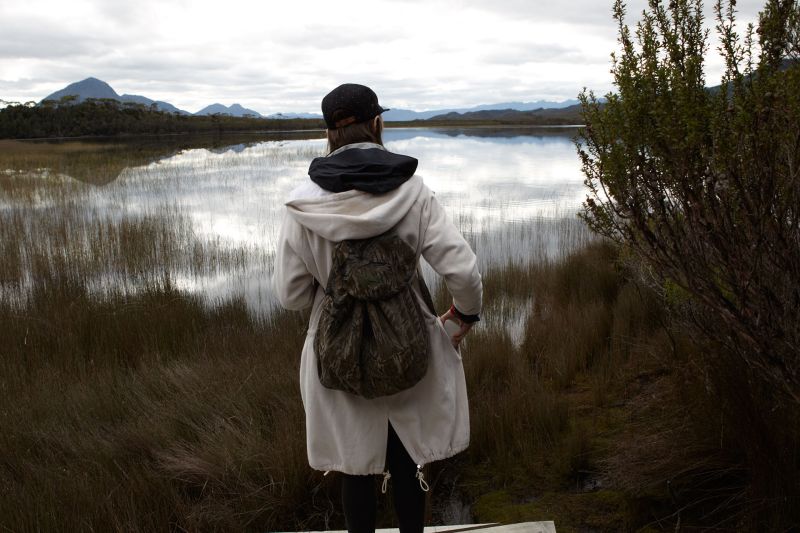Tasmania’s Southwest National Park is a mysterious and remote landscape that is surprisingly accessible on a day trip from Hobart. From the sky, shimmering aquamarine-coloured bays wrap around sandy beaches that fringe a vast sea of tea tree, banksia and eucalypts.
We fly over jagged peaks, wild rivers, a rugged coastline and mysterious-sounding places like Prion Bay and Precipitous Bluff.
The flight itself is an adventure.

Southwest National Park

I’m looking down on Tasmania’s Southwest National Park, which occupies a vast area of this remote corner of the island state.
Parts of the wilderness are more than 50 km from the nearest road and in most places the only access is by foot, boat or airplane.
Our aircraft lands on a white gravel landing strip at Melaleuca.

We pile out and walk along the winding boardwalk into the wilderness of Port Davey Marine Reserve.
The reserve extends inland for more than 20km to the north and east and is a patchwork of button grass moorlands, heathlands, rivers, bays and estuaries.

The landscape is ethereal and silent, a drowned valley with Bathurst Harbour at its centre. Look up into the sky at night and you’ll see the Tasmania Aurora shimmering above.
The valley was once a large plain that flooded as the sea level rose about 7000 years ago.
Much of the soil consists of organosols, or peat, which form from undecomposed plant material that accumulates under wet, humid and cool conditions.
Not far from the airstrip is a bird hide built by explorer, tin miner and environmentalist, Deny King. King (who passed away in 1991) was a tin miner who lived in Melaleuca for 50 years.
He discovered the extinct Banksia kingie shrub and was instrumental in preserving the habitat of the Orange-bellied parrot (Neophema chrysogaster).
Orange-bellied parrot

The critically endangered Orange-bellied parrot is a migratory bird that spends winters feeding in the coastal grasslands of Victoria, South Australia and NSW, before returning to Melaleuca to breed.
At last count, the wild population had declined to 50 birds and experts say the species might become extinct in the wild.
Not far from the hide, we explore the grounds of Deny King’s family home.
Our pilot, Thomas, has brought tea, biscuits and Tasmanian cheese for us to tuck into.
The picnic spot is the boat landing behind the house. It’s a tranquil and calming hideaway with lovely water views.
Needwonnee Walk


Then we trek into the swampy thickets of the former homeland of the Needwonnee people, the indigenous people of the region.
The Needwonnee Walk is an interpretive nature trail that conveys the simplicity of the lives of this ancient aboriginal culture.
Everything is made from materials gathered locally.
Rudimentary huts among the trees, a reed basket dangling from a branch and a paperbark canoe on a jetty beside Melaleuca Lagoon are some of the items on show.
Bathurst Harbour

At the end of our walk, we board a motor boat at Melaleuca Inlet and cruise to Bathurst Harbour.
There are no other boats in sight on this pristine waterway the size of Sydney Harbour.
Unlike Sydney Harbour, Bathurst Harbour is an inland harbour with a myriad of creeks and rivulets.
The boat slices through the mirror-like reflections of puffy clouds and blue sky, creating a mesmerising warp-like effect on the surface of the dark water.
It looks like ink rippling in a giant inkwell.
The colour of the water is due to stratification, or layering, which occurs when freshwater meets saltwater.
As freshwater is lighter than saltwater, a dark band of tannin-rich freshwater rises to sit on top of the clear saltwater.
Even though Bathurst Harbour is shallow (around five to seven metres deep), phytoplankton and marine plants struggle to survive in the inky harbour.
Only heart urchins, sea cucumber and polychaete worms live on the muddy harbour floor.
In contrast to the harbour, Bathurst Channel, which connects Bathurst Harbour to Port Davey, is a jewel of the marine reserve with over 500 species of marine invertebrates thriving in the channel.
Examples are anemones, sea urchins, sea stars and other species usually found in the ocean.
When we land back in Hobart, the sun has vanished leaving me to stare into the dark horizon with a warm feeling that my soul has been touched by this virgin landscape of Tasmania.
Discover Tasmania
There are direct flights to Tasmania from Melbourne, Sydney and Brisbane on Jetstar, Qantas, Virgin and Tiger Airways. Victorians can take a car aboard the Spirit of Tasmania from Melbourne. Par Avion has tours to South West Tasmania from $270.
Read this post to find out what to do in Tasmania.
Hobart Accommodation
While in Hobart, stay at:
Salamanca Wharf Hotel, a new contemporary apartment-style boutique hotel within walking distance from Salamanca Place.
Avalon City Retreat, a luxurious two-bedroom apartment atop a nine-story office tower with views of the city, park and river.
Plan Your Trip

Rent A Car – Find the best car rental rates at Discover Cars. They compare car hire companies to provide you with the best deal right now.

Find A Hotel – If you’re curious about this article and are looking for somewhere to stay, take a look at these amazing hotels.






